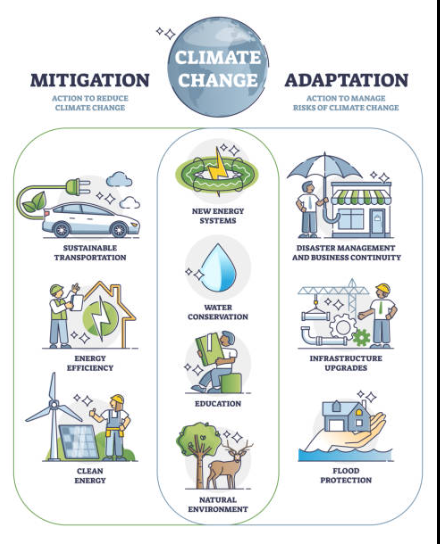Introduction
Climate change is one of the most pressing issues of our time, affecting every corner of the globe and touching every aspect of our lives. It refers to significant, long-term changes in the global climate, primarily driven by human activities. Understanding the causes, effects, and mitigation strategies of climate change is essential for developing effective solutions and safeguarding our planet for future generations.
Causes of Climate Change
At its core, climate change is driven by an increase in greenhouse gases (GHGs) in the Earth’s atmosphere. These gases trap heat from the sun, creating a “greenhouse effect” that warms the planet. The primary GHGs include carbon dioxide (CO2), methane (CH4), nitrous oxide (N2O), and fluorinated gases.
- Burning Fossil Fuels: The combustion of fossil fuels such as coal, oil, and natural gas for energy is the largest source of CO2 emissions. This occurs in power plants, vehicles, and industrial processes. Fossil fuels release large amounts of CO2 when burned, significantly increasing atmospheric concentrations.
- Deforestation: Trees play a crucial role in absorbing CO2 from the atmosphere. When forests are cleared for agriculture, logging, or development, this carbon sink is lost, and the stored CO2 is released back into the atmosphere. Deforestation not only contributes to increased CO2 levels but also disrupts ecosystems and biodiversity.
- Agricultural Practices: Agriculture contributes to climate change in several ways. Livestock farming produces significant amounts of methane, a potent GHG. Additionally, certain farming practices, such as the use of synthetic fertilizers, release nitrous oxide, another powerful greenhouse gas.
- Industrial Processes: Various industrial activities release greenhouse gases. For instance, cement production emits CO2 during the chemical transformation of limestone into cement. Additionally, the use of refrigerants and other chemicals in manufacturing processes can lead to the release of potent greenhouse gases.

Read More: Technological Innovations in Climate Change Mitigation
Effects of Climate Change
The impacts of climate change are widespread and multifaceted, affecting natural systems and human societies in profound ways.
- Rising Temperatures: Global average temperatures have increased, leading to more frequent and severe heatwaves. This rise in temperature affects weather patterns and contributes to the melting of polar ice caps and glaciers.
- Sea-Level Rise: The melting of glaciers and polar ice, combined with the thermal expansion of seawater as it warms, causes sea levels to rise. This threatens coastal communities with increased flooding and erosion.
- Extreme Weather Events: Climate change intensifies the frequency and severity of extreme weather events such as hurricanes, floods, droughts, and heatwaves. These events can cause widespread damage to infrastructure, disrupt communities, and impact agriculture.
- Ecosystem Disruption: Changes in temperature and precipitation patterns affect ecosystems and biodiversity. Species that cannot adapt quickly enough face the risk of extinction. For example, coral reefs, which are highly sensitive to temperature changes, are experiencing widespread bleaching events.
- Ocean Acidification: Increased CO2 levels are not only warming the planet but also leading to higher concentrations of carbonic acid in the oceans. This process, known as ocean acidification, harms marine life, particularly organisms with calcium carbonate shells or skeletons, such as corals and shellfish.
- Impact on Human Health: Climate change poses risks to human health through increased heat-related illnesses, the spread of vector-borne diseases (e.g., malaria, dengue), and exacerbated respiratory conditions due to poor air quality. Additionally, extreme weather events can lead to injuries, deaths, and mental health issues.

Mitigation Strategies
Addressing climate change requires a multifaceted approach to reduce greenhouse gas emissions and enhance resilience. Key mitigation strategies include:
- Transitioning to Renewable Energy: Shifting from fossil fuels to renewable energy sources, such as solar, wind, and hydropower, can significantly reduce CO2 emissions. Investments in renewable energy infrastructure and technology are crucial for this transition.
- Energy Efficiency: Improving energy efficiency in buildings, transportation, and industrial processes reduces energy consumption and emissions. This includes adopting energy-efficient appliances, retrofitting buildings, and promoting public transportation.
- Reforestation and Afforestation: Planting trees and restoring forests enhance carbon sequestration and help mitigate the effects of deforestation. Protecting existing forests and expanding green spaces also contribute to biodiversity conservation.
- Sustainable Agriculture: Implementing sustainable agricultural practices, such as reduced use of synthetic fertilizers, improved livestock management, and conservation tillage, can lower greenhouse gas emissions and improve soil health.
- Carbon Pricing: Introducing mechanisms such as carbon taxes or cap-and-trade systems can incentivize businesses and individuals to reduce their carbon footprint. By putting a price on carbon emissions, these policies encourage investments in cleaner technologies and practices.
- Adaptation Measures: While mitigation is essential, adaptation strategies are also crucial for managing the impacts of climate change. These include building resilient infrastructure, developing early warning systems for extreme weather, and implementing water management practices to cope with changing precipitation patterns.
- International Agreements: Global cooperation is vital for addressing climate change. Agreements like the Paris Agreement set targets for reducing greenhouse gas emissions and provide a framework for countries to collaborate on climate action.

Conclusion
Climate change represents one of the most significant challenges of our time, with far-reaching effects on the environment, economies, and human health. Understanding its causes, impacts, and the range of mitigation strategies available is crucial for developing effective solutions. By transitioning to renewable energy, improving energy efficiency, and implementing sustainable practices, we can work toward a more sustainable and resilient future. Addressing climate change requires collective action, innovation, and commitment at all levels of society to safeguard our planet for future generations.

Leave a comment